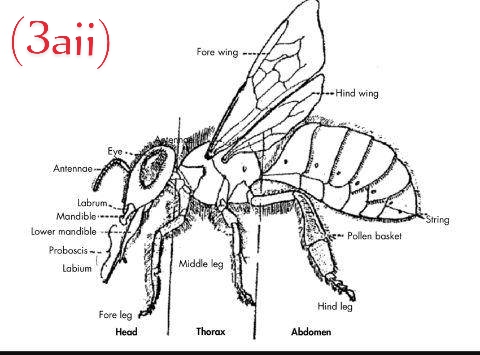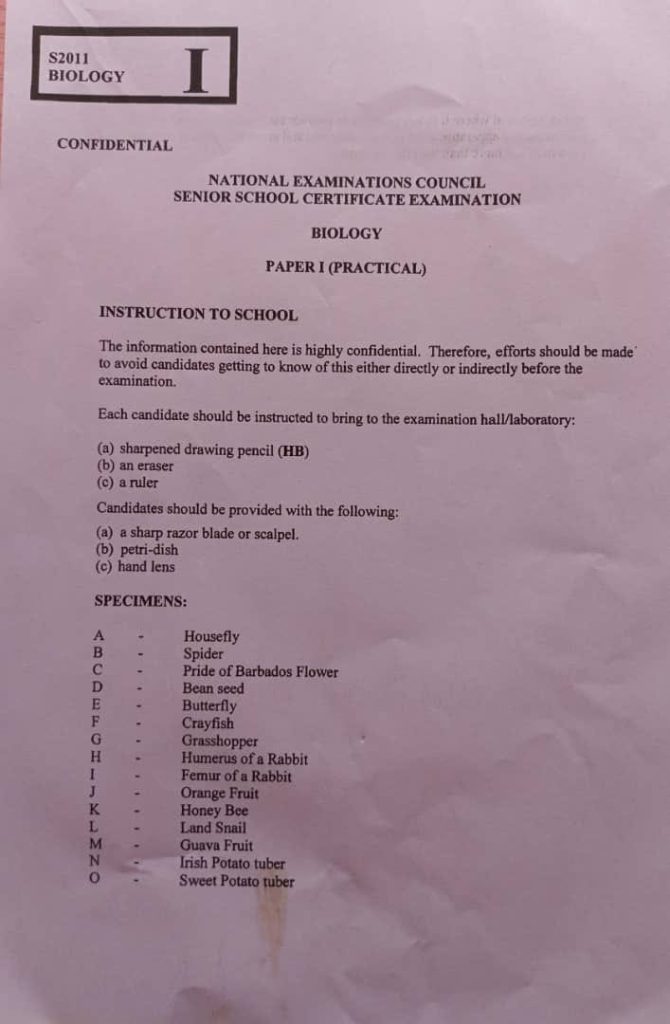NECO Biology (Practical) 2025
Number 1
(1ai)
A: Housefly
B; Spider
C; Pride of Barbados Flower
D; Bean seed
E; Butterfly
(1aii)
Specimen; A; – Insecta
Specimen; B; – Arachnida
(1bi)
(i)Typhoid fever
(ii)Dysentery
(1bii)
(i)Spongy proboscis.
(ii)Hairy body and legs.
(1biii)
Specimen; A;
(i)Housefly have six legs (like all insects)
(ii)Housefly have a distinct head, thorax, and abdomen
Specimen; B;
(i)spiders have eight legs.
(ii)spiders have a cephalothorax and abdomen.
(1ci)

(1cii)
Insecta
(1ciii)
(i)Colorful wings: With scales that give them vibrant colors and patterns.
(ii)Proboscis: A long, coiled tube used for feeding on nectar.
(iii)Compound eyes: Large eyes that provide wide-angle vision.
(iv)Antennae: Used for sensing the environment.
(1civ)
As they feed on nectar from flowers, they transfer pollen from one flower to another, facilitating the reproduction of the plant.
(1cv)
(i)Proboscis: Allows them to reach nectar deep within flowers, coming into contact with pollen.
(ii)Hairy body: Pollen can stick to their bodies and be transferred to other flowers.
==================
Number 2
(2ai)
F; Crayfish
G; Grasshopper
H; Humerus of a Rabbit
I; Femur of a Rabbit
J; Orange Fruit
(2aii)
Specimen; F; Malacostraca
Specimen; G; Insecta
(2aiii)
Food Source: Crayfish are an important food source for humans and are commercially harvested or farmed in many parts of the world.
(2aiv)
Specimen; F;
(i)They are primarily aquatic, living in freshwater or saltwater environments
(ii)They have gills for breathing underwater to survive.
Specimen; G;
(i)They are terrestrial, living on land.
(ii)They have a tracheal system for breathing air directly to their tissues.
(2bi)
Specimen; H; Located in the upper arm (forelimb), connecting the shoulder to the elbow.
Specimen; I; Located in the thigh (hindlimb), connecting the hip to the knee.
(2bii)
(i)Scapula (shoulder blade)
(ii)Radius and Ulna
(2c)

==================
Number 3
(3ai)
K; Honey Bee
L; Land Snail
M; Guava Fruit
N; Irish Potato tuber
O; Sweet Potato tuber
(3aii)

(3bi)
Specimen; K; Insecta
Specimen; L; Gastropoda
(3bii)
(i)Shell: Presence of a spiral shell for protection.
(ii)Foot: A flat, muscular foot used for locomotion.
(iii)Tentacles: Presence of tentacles on the head for sensory purposes.
(iv)Radula: A radula (a tongue-like structure with tiny teeth) used for feeding.
(3biii)
Specimen; K; Production of honey and pollination services.
Specimen; L; Some species are considered a delicacy and are farmed for food (escargot), contributing to local economies.
(3biv)
The type of placentation observed is axile placentation.
(3ci)
Specimen; N; Stem tuber
Specimen; O; Root tuber
(3cii)
Irish potatoes are propagated by vegetative propagation, specifically by planting seed potatoes (pieces of the tuber containing “eyes”).
==================
COMPLETED!!!

